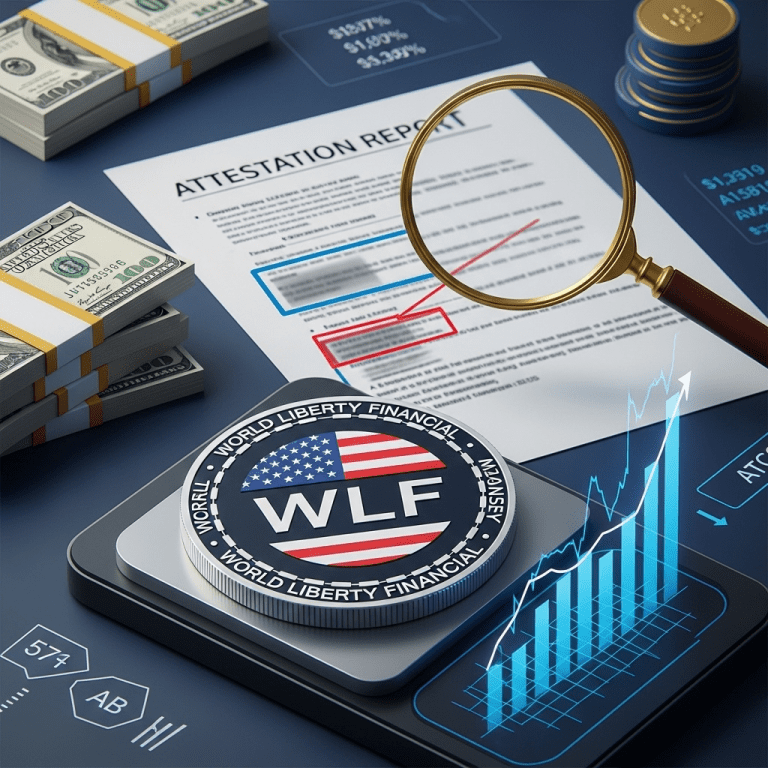The spotlight on transparency in the digital asset industry intensifies as Trump-Linked World Liberty Financial’s stablecoin needs better attestation reports, NYDIG says in a recent analysis. The commentary from NYDIG has prompted industry-wide discussions about the importance of reliable attestations for stablecoins — an issue gaining urgency in 2025 as regulatory scrutiny increases and investor confidence hinges on transparent practices.
Regulatory Pressure: Why Trump-Linked World Liberty Financial’s Stablecoin Needs Better Attestation Reports, NYDIG Says
The drive for improved attestation emerged after NYDIG, a prominent player in financial services for digital assets, reviewed the independent reports provided by World Liberty Financial (WLF) on its USD-backed stablecoin. Attestation reports are critical for stablecoins, as they verify that token reserves match the circulating supply and maintain asset backing at all times.
NYDIG’s concerns stem from what it describes as incomplete or outdated reserve audits. This puts World Liberty Financial in the crosshairs of both regulators and institutional investors, especially given its profile as a company with ties to former President Donald Trump’s business associates. Just last quarter, leading lawmakers publicly emphasized the need for robust, third-party attestation for all stablecoin issuers. Failing this, stablecoins risk facing trading restrictions, delistings, or greater regulatory intervention.
Attestation vs. Audit: The Critical Difference for Stablecoin Trust
Attestations are typically monthly, third-party confirmations of a stablecoin’s reserve status, while audits are more rigorous and thorough investigations of all underlying assets and liabilities. For a large-scale stablecoin like WLF’s, high-quality attestation can be the key to maintaining partnership opportunities with exchanges and institutions, as well as offering reassurance to investors.
NYDIG’s critique specifically highlights the risk that weak attestation standards can erode trust, potentially leading to the same concerns seen in previous stablecoin failures or depegs. Unlike proprietary crypto tokens, stablecoins require steady, predictable backing — making transparency paramount. Financial watchdogs are ramping up calls for stablecoin market discipline, paving the way for best-in-class standards in 2025.
Industry Concerns: Are Existing Attestation Practices Sufficient?
WLF’s recent attestation reports lagged behind issuance events and lacked granular reserve breakdowns, according to sources familiar with NYDIG’s findings. Competitor stablecoins, such as those issued by Circle or Paxos, now offer almost real-time transparency via on-chain proof-of-reserves and frequent independent attestations. This creates a new industry benchmark that World Liberty Financial is under pressure to meet.
Investors and analysts have historically relied on trusted attestation reports to distinguish reliable, fiat-backed stablecoins from those prone to value fluctuations. As the market matures, regulators and partners are increasingly demanding detailed, actionable reserve statements in response to risks of fraud, insolvency, or bankruptcy.
The Role of Transparency and Third-Party Verification in 2025
The crypto ecosystem is evolving rapidly, with regulatory authorities worldwide pushing for enhanced disclosures. NYDIG’s statement that Trump-Linked World Liberty Financial’s stablecoin needs better attestation reports underscores the growing importance of these mechanisms for risk mitigation. In a post-2024 environment shaped by both FTX fallout and new global stablecoin frameworks, there is no margin for error in stablecoin transparency.
Crypto market analysts note that robust, frequent attestation reports not only support uninterrupted trading and DeFi integrations but also foster stablecoin adoption in cross-border payments, remittances, and even government-backed pilots. Weaknesses in reporting can lead to market outflows and regulatory crackdowns, as authorities become increasingly intolerant of murky practices.
Political Ties and Public Perception: A Double-Edged Sword
World Liberty Financial’s perceived affiliation with Donald Trump’s network has kept the company in the headlines, but it also magnifies scrutiny of its business practices. Industry observers highlight that companies with celebrity or political connections must be especially vigilant. A larger media spotlight on reporting lapses can make or break public trust, especially as stablecoins gain mainstream status in payments and commerce.
In recent months, investors have gravitated towards digital assets backed by transparent reserves, as demonstrated by trends on institutional finance platforms. Public confidence is emerging as a competitive edge in 2025’s crowded stablecoin marketplace.
What’s Next for Stablecoins and Attestation Standards?
The way forward for World Liberty Financial — and by association, all stablecoin issuers — centers on embracing standardized, frequent, and thorough attestation protocols. NYDIG’s call for improved disclosures is already being echoed by institutional investors, market makers, and compliance bodies in Europe, Asia, and North America.
Many industry experts expect 2025 to see the rapid adoption of blockchain-based proof-of-reserves solutions, automated attestations, and unified attestation reporting templates. For WLF, aligning with these trends could reverse the negative sentiment triggered by NYDIG’s concerns and restore competitive positioning.
Continuous transparency and reliability will remain the gold standard for digital assets — not just to satisfy regulatory mandates, but to anchor the next generation of digital finance. For independent investors, staying up-to-date with the latest on stablecoin backing and auditing practices is essential for informed decision-making. Further analysis and detailed market breakdowns can help guide your portfolio strategies — visit industry research resources for deeper insights.
Conclusion: Trust, Regulation, and the Future of Stablecoins
The call from NYDIG reinforces a broader industry trend: Trump-Linked World Liberty Financial’s stablecoin needs better attestation reports if it hopes to stay compliant and competitive in 2025. As the market pushes for increased transparency, political affiliations and market share will offer little protection against the demand for robust, credible disclosures. The stablecoin sector’s path forward lies in openness, relentless improvement, and proactive engagement with emerging regulatory and industry norms.









